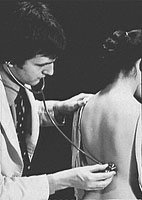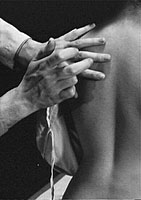[Skill Modules
>>
Pulmonary Examination
>>
Techniques
]
Techniques
There are many physical examination maneuvers described for evaluation of lung sounds. These are techniques of auscultation and percussion:
| Auscultation |
Percussion |
 |
 |
Since the complete pulmonary physical examination takes approximately ten minutes, for time-efficiency it is helpful to perform a screening exam, expanding techniques employed in a sequential fashion as indicated clinically:
Screening Exam Techniques
 |
- Auscultate for presence of crackles, wheezes and rub, alternating between left and right lung.
- Listen for bronchial breath sounds.
- Perform auscultatory percussion.
- Assess for excursion depth during inspiration.
- Assess for crackles in the lateral decubitus position (LDP).
|
Listen and Compare Sounds
Note: If the above exam is normal, no further maneuvers are likely to contribute to the diagnosis of lung pathology.
The clinical likelihood of pneumonia increases when focal abnormalities such as crackles or asymmetry between lung fields are present. In this setting the following maneuvers have historically been used in making the diagnosis of pneumonia and may be of interest.
 |
- Bronchophony
- Egophony
- Whispered pectoriloquy
- Tactile fremitus
Several of the techniques for auscultation and percussion are classical parts of the physical examination with little data about predictive value or reproducibility. No single maneuver is both highly sensitive and specific in detection of pneumonia; therefore, usually several maneuvers are performed to increase the accuracy.
The physiologic basis of vocal sounds may be found in the Pathophysiology section. Additional details of examination maneuvers and their origins may be found in the Historical section.
|
|



